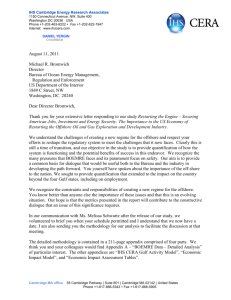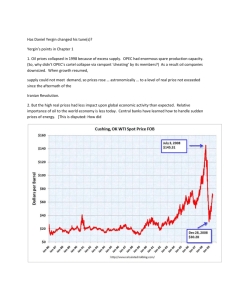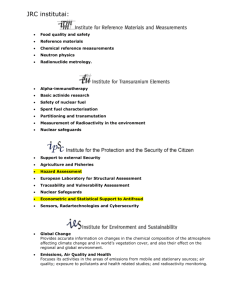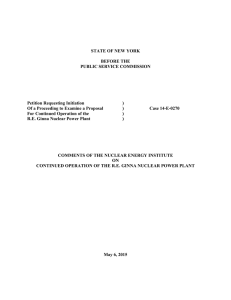Essay
advertisement
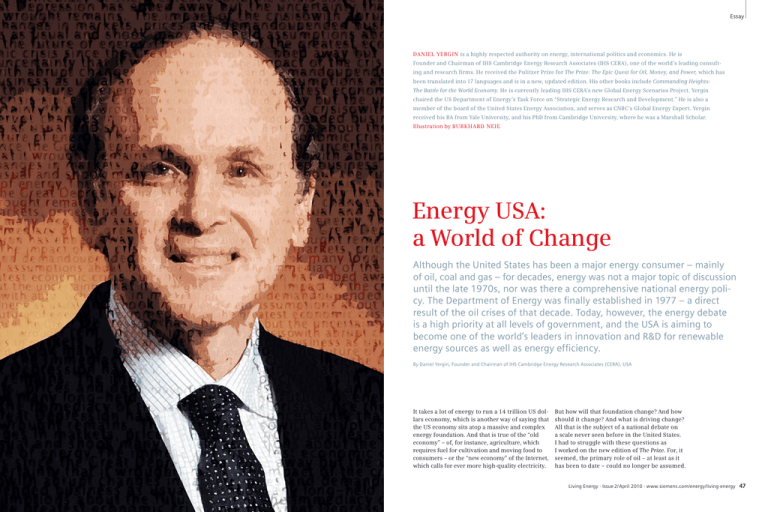
Essay DANIEL YERGIN is a highly respected authority on energy, international politics and economics. He is Founder and Chairman of IHS Cambridge Energy Research Associates (IHS CERA), one of the world’s leading consulting and research firms. He received the Pulitzer Prize for The Prize: The Epic Quest for Oil, Money, and Power, which has been translated into 17 languages and is in a new, updated edition. His other books include Commanding Heights: The Battle for the World Economy. He is currently leading IHS CERA’s new Global Energy Scenarios Project. Yergin chaired the US Department of Energy’s Task Force on “Strategic Energy Research and Development.” He is also a member of the board of the United States Energy Association, and serves as CNBC’s Global Energy Expert. Yergin received his BA from Yale University, and his PhD from Cambridge University, where he was a Marshall Scholar. Illustration by BURKHARD NEIE Energy USA: a World of Change Although the United States has been a major energy consumer – mainly of oil, coal and gas – for decades, energy was not a major topic of discussion until the late 1970s, nor was there a comprehensive national energy policy. The Department of Energy was finally established in 1977 – a direct result of the oil crises of that decade. Today, however, the energy debate is a high priority at all levels of government, and the USA is aiming to become one of the world’s leaders in innovation and R&D for renewable energy sources as well as energy efficiency. By Daniel Yergin, Founder and Chairman of IHS Cambridge Energy Research Associates (CERA), USA It takes a lot of energy to run a 14 trillion US dollars economy, which is another way of saying that the US economy sits atop a massive and complex energy foundation. And that is true of the “old economy” – of, for instance, agriculture, which requires fuel for cultivation and moving food to consumers – or the “new economy” of the Internet, which calls for ever more high-quality electricity. But how will that foundation change? And how should it change? And what is driving change? All that is the subject of a national debate on a scale never seen before in the United States. I had to struggle with these questions as I worked on the new edition of The Prize. For, it seemed, the primary role of oil – at least as it has been to date – could no longer be assumed. Living Energy · Issue 2/ April 2010 · www.siemens.com/energy/living-energy 47 Essay Essay As I thought it through, four changes seemed to be preeminent. The first is the globalization of energy demand. Through the 1990s, when one spoke about world oil demand, it was mainly in terms of the developed economies, led by the United States. No longer. Now the great question surrounds the pace of growth in developing countries, which, between 2000 and 2007, accounted for 85 percent of the growth in world demand. This rapid growth amplifies concerns about the security and availability of oil and other energy sources. The second big factor is climate change, which really only began to gain political traction in the United States about half a decade ago. Now, “President Barack Obama has set a ‘new energy economy’ as one of his most important priorities.” however, the US House of Representatives has passed a massive cap-and-trade bill. It has yet to pass the Senate, of course, where concerns about the state of the US economy could derail legislation. As an alternative, a 2007 Supreme Court decision has given the Environmental Protection Agency authority to regulate CO2 as a “pollutant,” which the EPA could take up if Congress does not deliver. Whatever the political outcome, throughout the US energy industry and policy world, people now speak of a “carbon-constrained world,” which would inevitably lead to shifts in the mix of sources in that energy foundation. The third factor is technology. In the United States today, there is an ever-increasing and greatly intensified focus on innovation all across the energy spectrum. And the fourth factor is an emphasis on and embrace of energy efficiency to a greater degree than ever before. All these forces are reshaping the US energy system – at the level of national policy, in corporate decision making, and on the part of consumers. But – and here is the big “but” – the US energy system is of such a scale and complexity, and has so much embedded capital, that it can48 Living Energy · Issue 2/ April 2010 · www.siemens.com/energy/living-energy not change quickly. New “entrants” not only have to demonstrate that they can deliver, but also prove themselves competitive at scale. The Evolution of a National Energy Policy With all the discussion of renewable and alternatives, the United States today is still overwhelmingly a hydrocarbon economy. Before the 1970s, no one really talked about “energy policy.” There were coal policies and natural gas policies and oil policies, many of which were run out of the Department of the Interior. The oil crises of the 1970s led to the establishment of the Department of Energy in 1977. The crises also unleashed a drive to develop a comprehensive, coherent national energy policy. That was much easier said than done, as battles over different aspects of energy came to be among the most dominating political issues. But public policy at the federal and state levels did, for the first time, give a boost to renewables. Yet, in the years thereafter, it became clear that energy policy went in cycles – sometimes getting a lot of attention, and sometimes almost seeming to fall off the table. And talk of renewable energy faded away. In the first decade of this century, renewables got a new boost when many of the individual states – now more than half – instituted mandates requiring that a certain percentage of electricity come from renewable energy. This was bolstered by tax credits at the federal level, although not with the consistency that sustained energy investment requires. The biggest beneficiary of the changes in renewable policy has been wind power. Indeed, its growth is such that it becomes increasingly difficult to call wind an “alternative” source of energy. It has become a conventional part of the mix. Of the 101 GW of electric power capacity currently projected to be added in the United States between 2009 and 2014, up to 40 percent could be wind. Yet as wind grows in scale, it creates a particular set of problems arising from its intermittency. Wind does not blow all the time. Indeed, on the hottest days in California, when power is needed most, the output of wind – as opposed to nameplate capacity – can fall dramatically. Meeting the challenge of intermittency is a top priority. There are three obvious answers. The first is to bundle wind with complementary capacity powered by natural gas, which can be switched on when the wind fades. A second is to expand and modernize the transmission net- work so that power can be moved more easily among regions and across state borders. But this can be a thorny political issue because of the federal nature of the US political system, where jurisdiction and responsibility is shared, sometimes testily, among Washington and state governments. With that said, improving transmission is a high priority. The third possible solution is to solve, in one way or the other, the problem of storing electricity, an option which is certainly getting a great deal of attention. Banking on New Technologies and Energy Efficiency The Administration of George W. Bush put particular emphasis on biofuels, especially ethanol made from corn (maize). The 2007 Energy Independence and Security Act provides that about a quarter of US motor fuel should be made from biofuels by 2022. But recent experience has demonstrated the limits of corn-based ethanol, meaning that a substantial part of that mandate will have to be met with second-generation cellulosic ethanol and other biofuels. The hitch is that no such thing exists on any commercial basis. So there is plenty of incentive here for innovation – but only twelve years to get it done! In the meantime, ethanol today comprises about 8 percent of total US gasoline by volume (and 5.5 percent by energy content, owing to the fact that ethanol has about two-thirds of the energy content of oil-based gasoline). However, this is already a very substantial growth from where biofuels were not more than half a decade ago. President Barack Obama has set a “new energy economy” as one of his most important priorities. To implement that vision, he has chosen one of the nation’s top scientists – Nobel Prizewinning physicist Steven Chu – to be Energy Secretary. The senior leadership of the Department of Energy is more science oriented than ever before in its 33-year history. Spending on energy research and development is slated to increase substantially, which, if maintained in subsequent administrations, will make its effects felt for many years to come by, among other things, creating long-term careers for new generations of scientists. But there is also an unanticipated short-term burst in terms of stimulus spending. A good part of the 37 billion dollars put out by the Department of Energy under the American Recovery and Reinvestment Act of 2009 has gone to support new technologies and research and development. The money is being applied to a wide range of initiatives. One of the most visible is the electric car, and specifically the batteries needed to power it. The objective is to reach the cost levels, the driving range, and the utility level that motorists require Facts and Figures The United States’ share of world energy is slightly less than its share of the total world economy. While US GDP is 23 percent of the world’s GDP, the US share of energy is 20 percent – down from 25 percent in 1998. Overall, the United States is twice as energy efficient as it was in the 1970s. Oil provides slightly over 37 percent of total energy, mostly concentrated in transportation. In 2009, on a net basis, 53 percent of total oil demand was met by imports, down from 57 percent in 2008, owing to a 4 percent drop in consumption between the two years. Coal is 21 percent of total energy – overwhelmingly concentrated in the generation of electric power. In turn, almost half of all the electricity in the United States is generated by coal, which is abundant and relatively inexpensive. Natural gas is over 24 percent of total energy, but is split in its markets between direct heating of homes, industrial feedstock and fuel, and power generation. The unconventional natural gas “revolution” will probably increase gas usage in power generation. Altogether, hydrocarbons provide 83 percent of total US energy. The “old” renewable – hydropower – provides about 3 percent of total energy for the United States, but is unlikely to see any growth, owing to popular opposition to new dams. But the “new” re- newables – wind and solar, in particular – are growing fast, albeit from a very small base. Wind today accounts for just 0.6 percent of total energy (though that is double what it was in 2007), and solar, just 0.1 percent. But public policy is determined to increase their market through mandates, fiscal incentives and subsidies. IHS CERA calculates that wind could account for as much as 40 percent of the new electric power capacity that is added over the next few years. US CO2 emissions in 2008 were slightly lower than in 2000. Source: Energy Information Administration, IHS CERA Living Energy · Issue 2/ April 2010 · www.siemens.com/energy/living-energy 49 Essay Essay The new emphasis is already evident in the automobile sector, which is turning a corner in terms of efficiency after a romance with fuel-inefficient SUVs. The 2007 energy legislation raised fuel efficiency standards for the first time in 32 years. IHS CERA believes that the United States actually reached “peak demand” in terms of oil consumption in 2007. What demand will look like in ten years will be determined by public policy, consumer tastes, shifting demographics (aging populations drive less), and innovation in engines. Will new engine designs, which can double the efficiency of the internal combustion engine, be widely adopted? Time will tell. Because of the absolute size of the US auto fleet (246 million vehicles), and the fact that only about 8 percent of the fleet turns over each year, electric cars – even with aggressive promotion from 2012 onward – would not have a significant effect on reducing gasoline demand until after 2025. But the psychological effect would be felt earlier. in order to be competitive. Another is the promotion of the smart grid and the modernization of the transmission network. The smart grid, which hardly existed as a concept five years ago, is today one of the hottest subjects in energy technology and policy. While there are different definitions, the essence is the harnessing of information and communication technologies to create a two-way relationship between consumers and electric suppliers in order to make the system much more efficient. Biofuels continue to be a significant focus of innovation. Major oil companies are increasing their investment in advanced biofuels – most notably, ExxonMobil’s decision to commit as much as 600 million dollars over ten years to develop commercial fuels out of algae. Yet what is clearly at the top of the agenda, as never before, is energy efficiency. The record of the United States on energy efficiency is often not well understood. The United States is twice as energy efficient today as it was in the 1970s. And there is widespread confidence that the United States has the potential to become much more energy efficient – that conservation is an immensely abundant fuel and one that can be tapped more quickly and often more cheaply than other sources. But, as my colleague Lawrence Makovich, CERA Vice President and Senior Advisor, has emphasized, energy efficiency is not free; like all investments, it involves trade-offs. Surprises and Innovation Where does nuclear power fit into all this? In fact, though little realized, nuclear power has been a dramatic success story over the last two decades. Some 20 years ago, 19 percent of electricity was produced from nuclear power. Today, 20 percent of electricity is also produced from nuclear power. US Energy Sources Comparison Biomass Hydro Hydro Nuclear 3.4 3.7 3.2 Geothermal 0.4 Nuclear Coal 19.7 8.5 0.1 Solar 0.5 Wind Biomass 2.5 3.5 Coal 22.5 Oil 43.7 25.9 Natural gas 1980 Values in percent 50 Living Energy · Issue 2/ April 2010 · www.siemens.com/energy/living-energy 37.5 Oil 23.9 Natural gas 2008 Source: Energy Information Administration (EIA) “Throughout the US energy industry […] people now speak of a ‘carbon-constrained world,’ which would inevitably lead to shifts in the mix of sources in that energy foundation.” But how can that be? Electricity consumption has increased by 35 percent since then, and no new nuclear power plants have been built during that time. Indeed, the number of plants in operation has actually decreased. The reason – and this is the success story – is that operating capability has improved so dramatically, and today’s nuclear fleet operates at almost 93 percent capacity, compared to 66 percent capacity in 1990. New nuclear plants are being built in China and India, but will any new plants be built in the United States? Nuclear power has a great plus in being a carbon-free source of electricity. In an effort to promote its development, the federal licensing process for new plants has been streamlined, but getting through it is still a challenge. Today there are over 20 applications to build new nuclear power plants, and at this writing it seems likely that at least two or three will begin construction before the end of this decade. There will certainly be surprises in energy in the years ahead. There always are. They could be delivered by innovation. With the intensified emphasis on innovation from a variety of sources – government, universities and research institutes, venture capital (which only got really interested in energy half a decade ago), and large technologically oriented industrial companies – we should expect surprises. And even more so when we consider the entrepreneurs and innovators drawn by the excitement and opportunity of energy. There has already been one big surprise in this new century, and it has the capacity to shift the national energy debate. Indeed, it is the most important energy innovation of the first decade of this century, although its potential impact was not recognized until only a few years ago. The innovation is what is called “unconventional natural gas.” It was not primarily the product of federal research and development policy. Rather, it was the result of private sector ingenuity, experimentation and risk-taking. Uniting two technologies – “fracing” of rocks and horizontal drilling – the independent sector of the natural gas industry has unlocked large volumes of natural gas that heretofore was trapped in shale rock. The potential is enormous – perhaps a doubling of US natural gas resources – or even more. It is still early days, but the implications are so significant that we at IHS CERA have created a national forum on the “Future of North American Energy” to explore and analyze how much the energy outlook may be changed. Because of the importance of the subject and the potential impact, a wide variety of organizations have joined in order to develop a deeper understanding and a common framework. We expect a growing policy impact from the unconventional gas. In a carbon-constrained world, these volumes make lower-carbon natural gas a much more formidable competitor of coal for new electric generation, and it could mean a much larger role of natural gas in the energy mix going forward. The impact of this innovation is already being felt around the world. The growth of unconventional natural gas means that the USA will be importing less liquefied natural gas (LNG) than assumed a few years ago, meaning more of the LNG will go to Europe and Asia. Moreover, the technology is now being exported to other parts of the world, including Central Europe and China, and in a couple of years we will start to see if the US experience can be replicated in Europe and Asia. The energy base that supports this 14 trillion dollars US economy may be very large, but it is changing in response to many forces – policy, consumer sentiment, company strategy, energy security and climate change considerations. Whatever the forces, what will be fundamental in the pace and direction of change is the ongoing drama of technological innovation. For it is innovation that gave us the energy economy we knew in the 20th century and that will also give us the energy economy we will come to know as this century proceeds. Living Energy · Issue 2/ April 2010 · www.siemens.com/energy/living-energy 51
